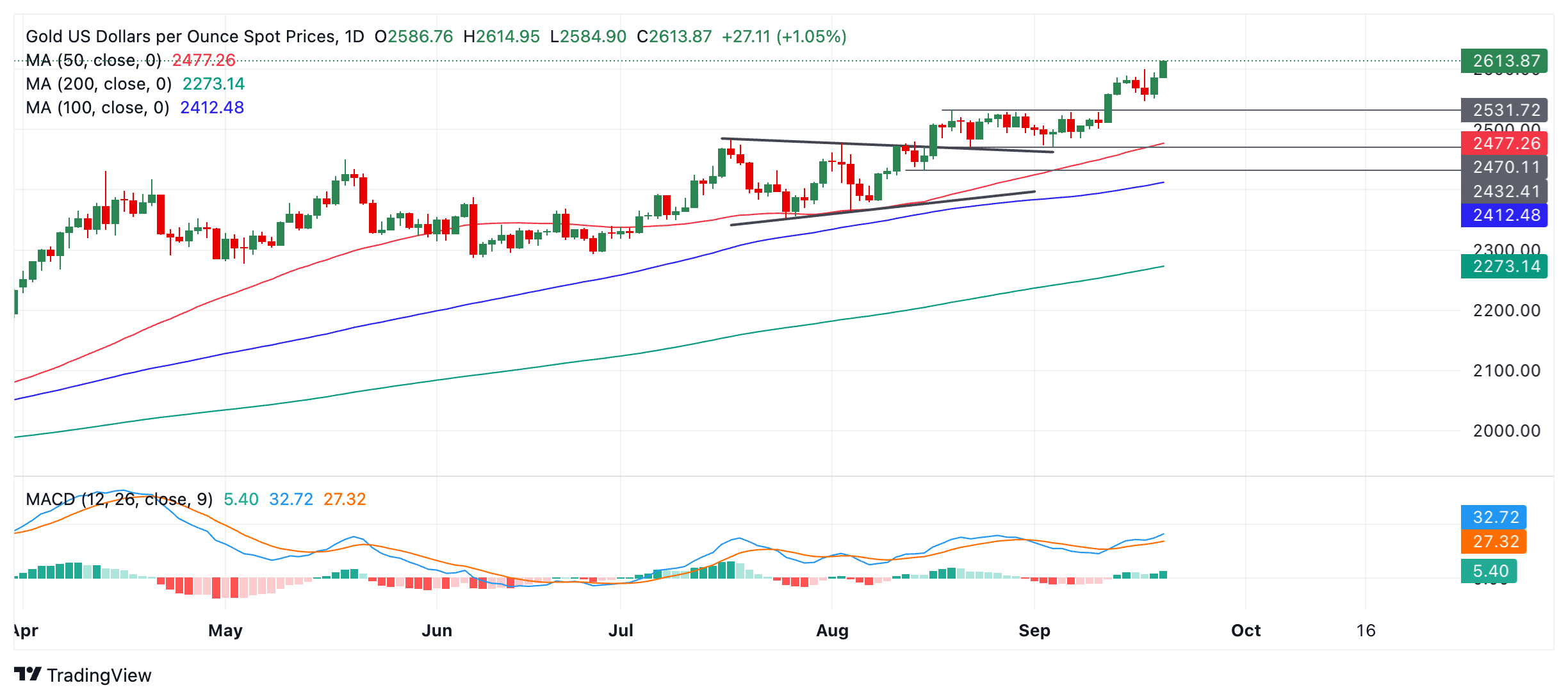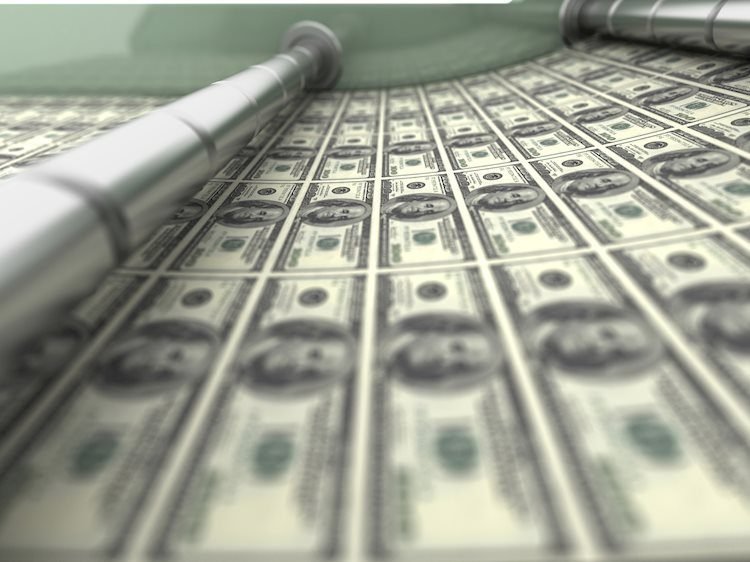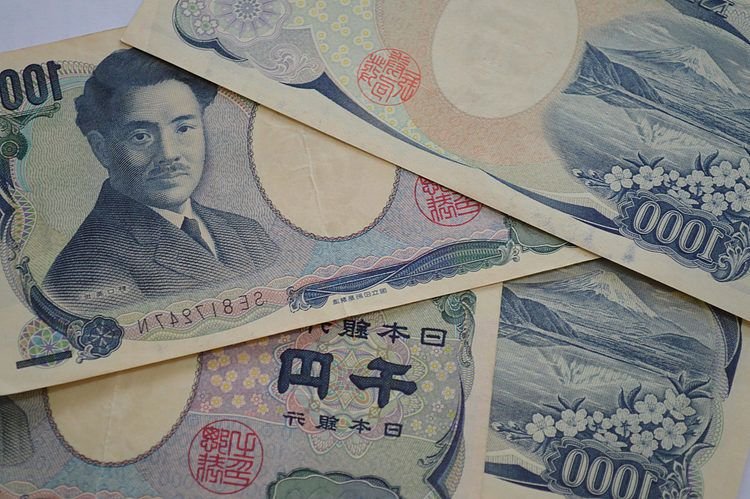- Gold breaks to new record highs on Friday as central banks worldwide are expected to follow the Fed’s example.
- The precious metal shot to a new high after the Fed’s decision to slash borrowing costs by 0.50% on Wednesday.
- As traders say, the “trend is your friend,” and technically, Gold is in a strong uptrend in all time frames.
Gold (XAU/USD) breaks to a new record high in the $2,610s on Friday on heightened expectations that global central banks will follow the Federal Reserve (Fed) in easing policy and slashing interest rates. Lower interest rates are positive for Gold, as they reduce the opportunity cost of holding the non-interest-paying asset, making it more attractive to investors.
Following Wednesday’s Fed decision, the South African Reserve Bank (SARB) cut its key interest rate by 25 basis points (bps) on Thursday – the first cut since the Covid pandemic in 2020. The Central Bank of the Philippines cut interest rates by 250 bps to 7.0% at its meeting on Friday. The Reserve Bank of India (RBI) is now also widely expected to slash interest rates in sympathy with the Fed when it next meets.
Although the People’s Bank of China (PboC) kept its key lending rates unchanged at the September fixing on Friday, the one and five-year loan prime rates lie at record lows of 3.35% and 3.85%, respectively, after the bank made a surprise cut in July. The Bank of Japan (BoJ), meanwhile, left rates unchanged at its meeting on Friday, despite some speculation of a rate hike in the offing.
Gold breaks above previous record highs
Gold smashes above the previous record highs set on Wednesday of $2,600 following the Fed’s decision. At this meeting, the US central bank decided to cut interest rates by a double-dose of 50 pbs (0.50%).
The upside for the yellow metal was capped, however, by the Fed’s broadly positive outlook for US growth, which the central bank saw remaining stable at about 2.0% per year until the end of 2027. This suggested a “soft landing” profile for the economy, which is broadly positive for sentiment. However, this was probably negative for the safe-haven Gold. Thus, the precious metal quickly fell after peaking.
At the same time, increased geopolitical risk aversion might be generating supportive safe-haven flows. Israel’s use of exploding pagers and walkie-talkies to eliminate and injure Hezbollah agents in Lebanon has increased the risk of an escalation in the Middle East conflict, potentially supporting the precious metal.
Technical Analysis: Gold makes new high as uptrend extends
Gold has broken through to new highs on Friday, above the previous record high of $2,600 set after the Fed meeting on Wednesday.
The technical analysis dictum says that “the trend is your friend,” which means the odds favor more upside for the yellow metal in line with the dominant long, medium, and short-term uptrends.
XAU/USD Daily Chart

The next targets to the upside are the round numbers: $2,650 first and then $2,700.
Gold is still not quite overbought, according to the Relative Strength Index (RSI) in the daily chart above, which also leaves room for more upside.
In the event that Gold’s RSI enters the overbought zone on a closing basis, however, it will advise traders not to add to their long positions.
If it enters and then exits overbought, it will be a sign to close longs and sell, as it would suggest a deeper correction is in the process of unfolding.
If a correction evolves, firm supports lies at $2,550, $2,544 (0.382 Fibonacci retracement of the September rally), and $2,530 (former range high).
Gold FAQs
Gold has played a key role in human’s history as it has been widely used as a store of value and medium of exchange. Currently, apart from its shine and usage for jewelry, the precious metal is widely seen as a safe-haven asset, meaning that it is considered a good investment during turbulent times. Gold is also widely seen as a hedge against inflation and against depreciating currencies as it doesn’t rely on any specific issuer or government.
Central banks are the biggest Gold holders. In their aim to support their currencies in turbulent times, central banks tend to diversify their reserves and buy Gold to improve the perceived strength of the economy and the currency. High Gold reserves can be a source of trust for a country’s solvency. Central banks added 1,136 tonnes of Gold worth around $70 billion to their reserves in 2022, according to data from the World Gold Council. This is the highest yearly purchase since records began. Central banks from emerging economies such as China, India and Turkey are quickly increasing their Gold reserves.
Gold has an inverse correlation with the US Dollar and US Treasuries, which are both major reserve and safe-haven assets. When the Dollar depreciates, Gold tends to rise, enabling investors and central banks to diversify their assets in turbulent times. Gold is also inversely correlated with risk assets. A rally in the stock market tends to weaken Gold price, while sell-offs in riskier markets tend to favor the precious metal.
The price can move due to a wide range of factors. Geopolitical instability or fears of a deep recession can quickly make Gold price escalate due to its safe-haven status. As a yield-less asset, Gold tends to rise with lower interest rates, while higher cost of money usually weighs down on the yellow metal. Still, most moves depend on how the US Dollar (USD) behaves as the asset is priced in dollars (XAU/USD). A strong Dollar tends to keep the price of Gold controlled, whereas a weaker Dollar is likely to push Gold prices up.

























